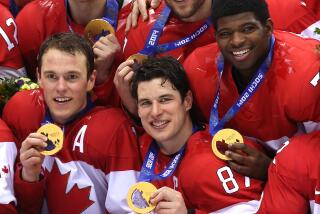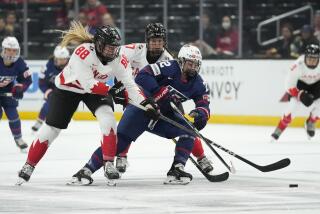Black and Blue on Ice : For Those Polar Souls Who Pay $10 a Night to Beat Their Friends, the Pain Comes Free
Inside Pickwick ice rink, the coldest night-spot in Burbank, Russ Carr was kneeling on the permafrost, doubled over in pain. A collision during a hockey game had put his right arm out of whack. He was moaning and wincing--not at all a pretty sight. A quick phone call to nearby St. Joseph’s Hospital seemed to be his only hope. With a little luck, the medics still had time to put everything back in place and give him at least partial use of the limb.
Then the buzzer sounded and Carr sprang to his feet, leaped over the boards with his bad arm and rejoined his linemates as if nothing had happened.
Watching Carr’s miraculous recovery was Bruce Teitell, director of the Los Angles County Hockey Assn. Teitell laughed at the possibility that Carr should have been on a stretcher, not the ice. “What do you think we’re playing here--baseball?” he said. “Our guys don’t sit out two weeks with a hangnail.”
Hockey players, of course, are noted for durability. In the National Hockey League, it is not unusual for a player to undergo minor surgery between periods. But NHL players are being paid a lot of money to ignore their stitches and play for the good of the team. In the LACHA, the players pay to play. The pain is free.
“I had a couple of broken ribs last year,” said Dr. John Halebian, who plays with Carr for the Cobras. “It was pretty hard getting up for work the next day. But there’s one advantage in being a doctor--you can medicate yourself.”
Teitell laughed again. “Injuries? We get a lot more than bowling.”
Teitell’s breath hung in the cold air. This was a weather scene from another world. Tomorrow’s forecast: sub-zero temperatures, ice storms, sleet. Perfect for hockey. The pond will freeze over. The kids will get out from school. From upstate New York to East Icicle, Nova Scotia, pickup games of hockey will be taking place, and little boys will fantasize about becoming the next Wayne Gretzky.
The Valley is one of the last places on Earth you’d expect to find an organized hockey league. There are only three full-size indoor rinks in the land of orange groves. For as long as anyone can remember, large frozen ponds haven’t been seen in the Valley, and the natives are more intimate with Frisbees and skateboards than pucks and skates. Which is why the majority of the 300 players in the LACHA are either a) transplanted Easterners and Canadians, or b) Californians who went to hockey-playing colleges.
Curiously, the founder and president of the league is c) none of the above. As a kid growing up in the Valley, Brad Berman learned his hockey on small indoor rinks at the Topanga Mall and the Lancaster YMCA. When he was 11, his parents moved to the Bay Area, which has a large boys’ hockey program. Berman began getting serious about hockey. At 16, he played on the state championship midget team. In 1979, he returned to Los Angeles and became a member of the police department.
“I started an ice hockey league within the LAPD,” said Berman, now a vice cop in Van Nuys, “but there was no one for us to play. The LACHA just sort of evolved out of that league to provide us with competition. The funny thing is, there’s no LAPD team anymore, and only a half-dozen policemen who play in the LACHA.”
The Zamboni glazed the ice after the 7:30 p.m. game between Team California--the best teen-agers in the state--against a team from the LACHA. In the 9 p.m. game, Berman’s team, the Cobras, was to play the Flyers in their regular-season opener. As the players changed in the locker room adjacent to the outdoor pool, they knew the NHL was a long way off. The rink alone, with its dim lighting and slapshot streaks on the plexiglass, is enough to wipe out any illusions of future glory. But that doesn’t make any difference to these guys.
“When my team won the championship last season,” said Teitell, who coaches the Sabres, “our reaction was the same as if we’d won the Stanley Cup. My players doused me with champagne and threw me in the shower. It was a great feeling.”
Most of the players in the league are like Ira Schwartz, roly-poly goalie and captain of the Flyers who grew up playing hockey on the frozen playgrounds of New York City. A few years ago, he worked as a target for the New York Rangers as their practice goalie. “I love hockey, but I never wanted to play pro,” he said. “When your hobby becomes a job, it’s no longer fun.”
Hockey can be an expensive hobby. Aside from paying $10 a game for the privilege of getting bashed against the boards during a 30-game season, the players in the LACHA must supply their own uniforms and equipment, usually buying them at the half-dozen hockey shops in the metropolitan area. Skates can cost from $150 to $200, pants and gloves more than $120, pads as much as $75. Even socks are $35. And renting the rink costs $110 an hour.
In the locker room, the players removed their gear from large canvas bags and put on the layers of protection that kept them out of intensive care. The Cobras wrapped their own ankles and taped one another’s wrists. As Teitell says, “Hockey isn’t a contact sport, it’s a collision sport.” Injuries are frequent, but there isn’t a team doctor. Halebian, a podiatrist, can only help out with cases of athlete’s foot.
With their ice time approaching, the players got last-minute notes from captain Steve Grimme. They had played four practice games but still weren’t looking like the 1955 Montreal Canadiens. Grimme was griping about the no-shows. “We won’t be able to compete without a better turnout (18 players are on the roster),” he said. “The other teams will wear us down. We need 2 1/2 to 3 lines to be competitive. If you can’t make it for a game or a practice, call me at home and leave a message on my machine.”
Toe Blake never had problems like Grimme. He talked to the players about retrieving their own pucks during practice, keeping their lines even and looking “like a team out there.” And then there was the sensitive subject of dirty jerseys. “Wash ‘em,” he instructed, raising the specter of fans being turned off by ring around the collar.
Grimme also announced that the Cobras were trying out a couple of players, one of them Barry Burke, a former member of Team U.S.A. Burke hadn’t been on the ice since suffering a back injury two years ago. Since he couldn’t play hockey, the logical thing to do was move to Los Angeles. “I might as well be on the beach,” he said. Burke would be making his comeback in a borrowed blue Cobra jersey.
The Cobras and the Flyers took the ice for their eight-minute warm-up. There were a dozen fans in the stands, mostly wives and girlfriends. Terri Berman, six months pregnant, is secretary of the league. Until she married Brad three years ago, she had never been to a hockey game. Now her life revolves around them.
“We were at a Kings game at the Forum,” Brad Berman said, “but it was real boring, so we left early and went to one of our (LACHA) Division 1 games.”
To real hockey fans, LACHA games are probably more boring than NHL games. In the NHL, the monotony of a breakaway or a short-handed goal is often interrupted by a bloody fight or, even better for real hockey fans, a bench-clearing brawl. The LACHA has the sames rules as the NHL but makes fighting a major offense. First offenders receive a one-game suspension and a $15 fine, a lot of money if you’re making $200 a week. Chronic brawlers are tossed out of the league. As a result, there are few fights, which is probably why only a dozen real hockey fans show up for games.
“You’ll see flare-ups, guys with smoke coming out their ears,” Teitell said, “but they’ll walk away from a fight. They know they have to go to work the next day.”
Games in the LACHA aren’t violent, but that doesn’t mean they’re not physical. Teitell pointed to the Cobras’ Dave Hoover, who was coaching instead of playing because of a badly dislocated elbow. Before the game, Hoover had notions of suiting up. He even went to the extreme of cutting off his cast with garden shears.
“Hockey is different than any other sport,” Teitell said, “and hockey players have to be a different breed. It has a lot to do with macho. A macho thing happens to a guy when he puts on those skates and steps on the ice. Like my girlfriend said, there’s a certain insanity to hockey. On the ice, there could be two guys who absolutely want to kill each other, but after the game, they’ll go out for a beer together.”
When Halebian scored a goal for the Cobras, his wife Lena was in the video-game room trying to entertain their son, Jaxon, 2. She was holding him up to the wheel of the Sprint arcade game, plunking in quarters as he attempted to race a car around a TV screen. Lena met her husband in an ice rink. Hockey has become their Southern California life style. Almost every week, Halebian referees twice and plays twice. They just bought Jaxon his first ice skates.
Lena Halebian took up ice skating three years ago. Alison Wong was in her class. While Lena went on to become a mother, Alison was becoming a hockey player, the only woman in Division 1. She plays for the Flyers, who voted unanimously to keep her on the roster. Players for other teams aren’t as supportive, however.
“You feel like a jerk if you hit her and a jerk if you don’t,” said Mark Grimme of the Cobras.
Wong, 26, weighs only 115 pounds and isn’t expected to body-check opponents or slam into the boards to root out the puck. During the game against the Cobras, when she accidentally clipped a player with her stick, she immediately apologized, saying, “Oops, I’m sorry.” She’s playing in Division 1, she said, because the caliber of play in Division 2 isn’t challenging enough for her. But she realizes that her presence causes resentment.
“Hockey is a man’s sport,” she said, “and there are a few chauvinists out there. But at least nobody takes runs at me and tries to cream me. I’m lucky, I still have all my teeth.”
The game ended in a 4-4 tie, the Flyers scoring last with 1:51 left. The Cobras wobbled back to their locker room on their skates. Barry Burke thought the quality of play “was better than I expected” and was relieved that his back stood up to the test. Capt. Steve Grimme was whipped. He and his brother Mark were the last ones to leave.
“You get sore playing this game,” Steve said, slowly stowing his gear, “but it’s the only thing I get really psyched to do.”
More to Read
Go beyond the scoreboard
Get the latest on L.A.'s teams in the daily Sports Report newsletter.
You may occasionally receive promotional content from the Los Angeles Times.






